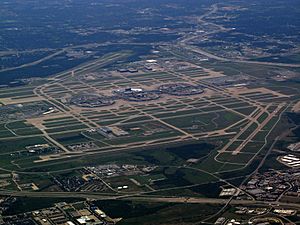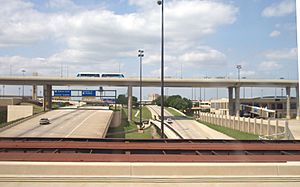Dallas Fort Worth International Airport facts for kids
Quick facts for kids
Dallas/Fort Worth International Airport
|
|||||||||||||||||||||||||||||||||||
|---|---|---|---|---|---|---|---|---|---|---|---|---|---|---|---|---|---|---|---|---|---|---|---|---|---|---|---|---|---|---|---|---|---|---|---|
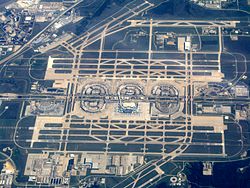 |
|||||||||||||||||||||||||||||||||||
| Summary | |||||||||||||||||||||||||||||||||||
| Airport type | Public | ||||||||||||||||||||||||||||||||||
| Owner | Cities of Dallas and Fort Worth | ||||||||||||||||||||||||||||||||||
| Operator | DFW Airport Board | ||||||||||||||||||||||||||||||||||
| Serves | Dallas–Fort Worth metroplex | ||||||||||||||||||||||||||||||||||
| Location | Grapevine, Irving, Euless, and Coppell In Tarrant and Dallas counties, Texas, United States |
||||||||||||||||||||||||||||||||||
| Opened | September 23, 1973 | ||||||||||||||||||||||||||||||||||
| Hub for |
|
||||||||||||||||||||||||||||||||||
| Focus city for | |||||||||||||||||||||||||||||||||||
| Built | 1969–1973 | ||||||||||||||||||||||||||||||||||
| Time zone | Central Standard Time (CST) (−06:00) | ||||||||||||||||||||||||||||||||||
| • Summer (DST) | Central Daylight Time (CDT) (−05:00) | ||||||||||||||||||||||||||||||||||
| Elevation AMSL | 607 ft / 185 m | ||||||||||||||||||||||||||||||||||
| Coordinates | 32°53′49″N 097°02′17″W / 32.89694°N 97.03806°W | ||||||||||||||||||||||||||||||||||
| Website | dfwairport.com | ||||||||||||||||||||||||||||||||||
| Map | |||||||||||||||||||||||||||||||||||
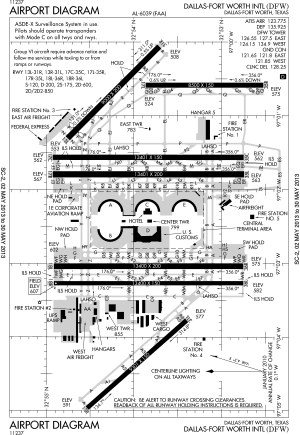 FAA airport diagram |
|||||||||||||||||||||||||||||||||||
| Runway | |||||||||||||||||||||||||||||||||||
|
|||||||||||||||||||||||||||||||||||
| Statistics (2022) | |||||||||||||||||||||||||||||||||||
|
|||||||||||||||||||||||||||||||||||
|
Sources: Dallas/Fort Worth International Airport
|
|||||||||||||||||||||||||||||||||||
Dallas/Fort Worth International Airport (DFW) is a huge airport in Texas, USA. It's also known as DFW Airport or just DFW. This airport is super important for the Dallas–Fort Worth metroplex area.
DFW is the main base for American Airlines, a very big airline. It's one of the busiest airports in the world! In 2021, it was the third busiest for how many planes took off and landed. It was also the second busiest for how many passengers traveled through it. DFW is a major international airport, meaning it handles many flights to and from other countries.
The airport is located right between the cities of Dallas and Fort Worth. It covers parts of four different cities: Grapevine, Irving, Euless, and Coppell. DFW is one of the largest airports in the United States by land area, covering about 17,207 acres (about 27 square miles)! It's so big it even has its own post office and emergency services like police and fire departments.
DFW Airport offers flights to 260 different places around the world. This includes 193 places within the U.S. and 67 international spots. Only a few airports globally fly to over 200 destinations, and DFW is one of them!
Contents
History of DFW Airport
How the Airport Was Planned
Back in 1927, Dallas and Fort Worth first thought about building one big airport together. But they couldn't agree, so each city built its own. Dallas had Love Field, and Fort Worth had Meacham Field.
Years later, in the 1960s, the government said they wouldn't give money for separate airports anymore. Dallas Love Field was getting too crowded, and the other airports weren't used much. So, in 1964, the cities finally agreed on a spot for a new, shared airport. This land was bought in 1966, and construction started in 1969.
The new airport was first called the North Texas Regional Airport. People in the area voted to approve it. The design for the airport changed over time. It was originally planned to have pier-shaped terminals. But in 1968, they decided on semicircular terminals. This design helped keep loading areas separate and made more room for parking. They planned for thirteen terminals, but only four were built at first.
Opening and Early Days
DFW Airport officially opened on January 13, 1974. It cost about $700 million to build. When it opened, it was the largest airport in the world by land area! One cool thing about the airport in its early days was the Vought Airtrans. This was the world's first fully automated system to move people around the airport. It was later called the Airport Train and then the TrAAin.
When DFW opened, it had four terminals: 2W, 2E, 3E, and 4E. Many airlines started flying there, including American Airlines and Braniff International Airways. Braniff was a big airline at DFW in the early years. They even had flights to London and other international places. DFW was one of only four U.S. airports to have flights with the super-fast Concorde plane!
In 1981, American Airlines made DFW its main hub. A hub is like a central station where many flights connect. American Airlines moved its headquarters near DFW in 1983. By 1991, American Airlines was using a lot of the airport's terminals. They also started flying to far-off places like London and Tokyo.
Another airline, Delta Air Lines, also had a hub at DFW in the 1990s. But in 2004, Delta decided to close its DFW hub. They moved their flights to other airports to save money.
In 1989, the airport planned to add more runways. After some legal challenges, the airport won, and a seventh runway opened in 1996. DFW now has four main runways that are all over 13,400 feet long. This makes DFW the only airport in the world with four paved runways longer than 4,000 meters (about 13,123 feet).
In 2005, Terminal D opened for international flights. Also, the DFW Skylink started running. This is a modern, fast train system that takes passengers between terminals inside the airport. It replaced the older Airport Train system. In 2014, the world's largest passenger plane, an Airbus A380 from Qantas, landed at DFW for the first time.
DFW Airport has won awards for passenger satisfaction. In 2018, it opened the first full-service emergency room right on airport property!
The airport has been working on a big project called "Terminal Renewal and Improvement Program" (TRIP). This project cost $2.7 billion and updated three of the original terminals (A, B, and E). These renovations were finished by the end of 2017.
The Future of DFW
DFW Airport and American Airlines are planning to build a sixth terminal, called Terminal F. This project is expected to cost billions of dollars. It will add up to 24 new gates. They also plan to update Terminal C, which is the last original terminal to be renovated. The goal is to help the region grow and compete with other big international business centers.
In 2022, Frontier Airlines announced it would open a base for its pilots and flight attendants at DFW. They will also add more flights from Terminal E.
Airport Layout and Features
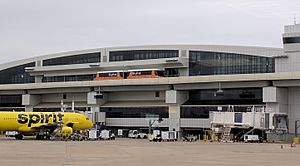
DFW Airport has five main terminals and 174 gates. The terminals are shaped like half-circles. This design helps you get from your car to your plane easily and reduces traffic. The DFW Skylink train system helps passengers travel quickly between gates. It takes about seven minutes on average to get around.
Terminal D is mainly for international flights. It has special facilities to check passports and customs for people arriving from other countries. It can even handle the giant Airbus A380 planes. Other terminals handle domestic flights. American Airlines flies from every terminal at DFW.
Terminals
- Terminal A has 26 gates.
- Terminal B has 45 gates (35 in the main terminal and 10 in a smaller building).
- Terminal C has 29 gates.
- Terminal D has 33 gates.
- Terminal E has 41 gates (26 in the main terminal and 15 in a smaller building).
Hotels at the Airport
There are two Hyatt hotels right in the middle of the airport.
- The Hyatt Regency has 811 rooms and is next to Terminal C.
- The Grand Hyatt opened in 2005 and has 298 rooms. It's located right above Terminal D, so you can walk straight to check-in.
Getting Around DFW
The main road through the airport is called International Parkway. It connects to other major highways around Dallas and Fort Worth.
You can also get to DFW by bus and train:
- Buses from Dallas Area Rapid Transit (DART) and Trinity Metro serve the airport.
- Three train systems connect to DFW:
* The DART Light Rail has a station at Terminal A, taking you to Dallas. * TEXRail is a train that connects Terminal B to downtown Fort Worth. * The Trinity Railway Express (TRE) also serves the airport area, with a shuttle bus connecting to the airport.
If you need to rent a car, there's a big center at the south end of the airport. It has ten different rental car companies. Shuttle buses take you from the terminals to the rental car center.
Other Cool Features
DFW Airport has its own police, fire, and emergency medical services.
In 1995, the airport opened Founders' Plaza. This is a special park where you can watch planes take off and land. It has binoculars, speakers that play air traffic control voices, and a tall beacon. It's a great spot for plane spotting!
Airlines and Destinations
Passenger Flights
| Airlines | Destinations | Refs |
|---|---|---|
| Aeroméxico Connect | Mexico City | |
| Air Canada | Toronto–Pearson | |
| Air Canada Express | Montréal–Trudeau | |
| Air France | Paris–Charles de Gaulle | |
| Alaska Airlines | Portland (OR), Seattle/Tacoma | |
| American Airlines | Albany (begins October 5, 2023), Albuquerque, Amarillo, Aruba, Asheville, Atlanta, Austin, Bakersfield, Baltimore, Belize City, Birmingham (AL), Bogotá, Boise, Boston, Buenos Aires–Ezeiza, Buffalo, Burbank, Calgary, Cancún, Cedar Rapids/Iowa City, Charleston (SC), Charlotte, Chicago–O'Hare, Chihuahua, Cincinnati, Cleveland, Colorado Springs, Columbia (SC), Columbus–Glenn, Cozumel, Denver, Des Moines, Destin/Fort Walton Beach, Detroit, Dublin, Durango (MX), Dayton, Eagle/Vail, El Paso, Eugene, Fayetteville/Bentonville, Fort Lauderdale, Fort Myers, Frankfurt, Fresno, Grand Cayman, Grand Rapids, Greensboro, Greenville/Spartanburg, Guadalajara, Guatemala City, Harrisburg, Hartford, Honolulu, Houston–Intercontinental, Huntsville, Indianapolis, Jackson Hole, Jacksonville (FL), Kahului, Kansas City, Key West, Knoxville, Las Vegas, León/Del Bajío, Lexington, Liberia (CR), Little Rock, London–Heathrow, Los Angeles, Louisville, Lubbock, Madison, Madrid, Mazatlán, McAllen, Memphis, Mexico City, Miami, Midland/Odessa, Milwaukee, Minneapolis/St. Paul, Montego Bay, Monterey (CA), Monterrey (MX), Montreal–Trudeau, Montrose, Morelia, Nashville, Newark, New Orleans, New York–JFK, New York–LaGuardia, Norfolk, Oaxaca, Oklahoma City, Omaha, Ontario, Orange County, Orlando, Palm Springs, Paris–Charles de Gaulle, Pensacola, Philadelphia, Phoenix–Sky Harbor, Pittsburgh, Portland (OR), Puerto Vallarta, Punta Cana, Querétaro, Raleigh/Durham, Reno/Tahoe, Richmond, Roatan, Rome–Fiumicino, Sacramento, St. Louis, St. Thomas, Salt Lake City, San Antonio, San Diego, San Francisco, San Jose (CA), San José de Costa Rica–Juan Santamaría, San José del Cabo, San Juan, San Luis Obispo, San Luis Potosí, San Pedro Sula, San Salvador, Santa Barbara, Santiago de Chile, São Paulo–Guarulhos, Sarasota, Savannah, Seattle/Tacoma, Seoul–Incheon, Shanghai–Pudong, Sioux Falls, Spokane, Syracuse, Tampa, Tokyo–Haneda, Tokyo–Narita, Toronto–Pearson, Tucson, Tulsa, Vancouver, Washington–Dulles, Washington–National, West Palm Beach, Wichita, Wilmington (NC) Seasonal: Amsterdam, Anchorage, Auckland, Bangor, Bozeman, Burlington (VT), Durango (CO), Glacier Park/Kalispell, Gunnison/Crested Butte, Hayden/Steamboat Springs, Ixtapa/Zihuatanejo, Kailua-Kona, Missoula, Nassau, Panama City (FL), Portland (ME), Providenciales, Rapid City, Tegucigalpa/Comayagua, Traverse City |
|
| American Eagle | Abilene, Aguascalientes, Alexandria, Amarillo, Asheville, Aspen, Augusta (GA), Baton Rouge, Beaumont, Billings, Birmingham (AL), Bismarck, Bloomington/Normal, Brownsville/South Padre Island, Cedar Rapids/Iowa City, Champaign/Urbana, Chattanooga, Chihuahua, College Station, Colorado Springs, Columbia (MO), Corpus Christi, Dayton, Des Moines, Destin/Fort Walton Beach, Durango (CO), El Paso, Evansville, Fargo, Fayetteville/Bentonville, Fayetteville (NC), Flagstaff, Fort Smith, Fort Wayne, Gainesville, Garden City, Grand Island, Grand Junction, Grand Rapids, Gulfport/Biloxi, Harlingen, Houston–Hobby, Huntsville, Idaho Falls, Jackson (MS), Killeen/Fort Hood, Lafayette, Lake Charles, Laredo, Lawton, Lexington, Longview, Louisville, Lubbock, Madison, Manhattan (KS), Memphis, Midland/Odessa, Mobile–Regional, Moline/Quad Cities, Monroe, Monterey (CA), Monterrey (MX), Montgomery, Montrose, Panama City (FL), Pensacola, Peoria, Rapid City, Roswell, San Angelo, Santa Fe, Shreveport, Sioux Falls, South Bend, Springfield/Branson, Stillwater, Tallahassee, Texarkana, Toronto–Pearson, Torreón/Gómez Palacio, Tri-Cities (TN), Tulsa, Tyler, Waco, Wichita, Wichita Falls, Yuma, Zacatecas Seasonal: Acapulco, Burlington (VT), Daytona Beach, Eagle/Vail, Glacier Park/Kalispell, Hilton Head, Huatulco, Ixtapa/Zihuatanejo, Loreto, Manzanillo, Mérida, Myrtle Beach, Santa Rosa, Sarasota, St. George (UT) |
|
| Avianca El Salvador | San Salvador | |
| Boutique Air | Carlsbad (NM) (ends November 4, 2023) | |
| British Airways | London–Heathrow | |
| Contour Airlines | Fort Leonard Wood, Greenville (MS) | |
| Delta Air Lines | Atlanta, Boston, Detroit, Los Angeles, Minneapolis/St. Paul, New York–JFK, New York–LaGuardia, Salt Lake City | |
| Denver Air Connection | Clovis (NM) | |
| Emirates | Dubai–International | |
| Finnair | Helsinki | |
| Frontier Airlines | Baltimore, Chicago–Midway, Denver, Las Vegas, New York–LaGuardia, Miami, Montego Bay, Orange County, Orlando, Philadelphia, Phoenix–Sky Harbor, Raleigh/Durham, San Diego, San Francisco, San Juan, Tampa Seasonal: Atlanta, Cancún, Cincinnati, Cleveland, Ontario, Salt Lake City |
|
| Iberia | Madrid | |
| Japan Airlines | Tokyo–Haneda | |
| JetBlue | Boston | |
| Korean Air | Seoul–Incheon | |
| Lufthansa | Frankfurt | |
| Qantas | Melbourne, Sydney | |
| Qatar Airways | Doha | |
| Red Way | Seasonal: Lincoln | |
| Southern Airways Express | El Dorado (AR), Harrison (AR), Hot Springs | |
| Spirit Airlines | Atlanta, Baltimore, Boston, Cancún, Charlotte, Chicago–O'Hare, Detroit, Fort Lauderdale, Las Vegas, Los Angeles, Miami, New Orleans, Newark, New York–LaGuardia, Oakland, Orlando, Pensacola, Philadelphia, Phoenix–Sky Harbor, San Jose (CA), San Juan, Tampa Seasonal: Myrtle Beach, San Diego, San José del Cabo |
|
| Sun Country Airlines | Las Vegas, Minneapolis/St. Paul Seasonal: Cancún, Cozumel, Liberia (CR), Montego Bay, Orange County, Palm Springs, Puerto Vallarta, Punta Cana, San José del Cabo |
|
| Turkish Airlines | Istanbul | |
| United Airlines | Chicago–O'Hare, Denver, Houston–Intercontinental, Newark, San Francisco, Washington–Dulles | |
| United Express | Chicago–O'Hare, Denver, Houston–Intercontinental, Newark, Washington–Dulles | |
| VivaAerobús | Mexico City, Monterrey | |
| Volaris | Guadalajara, Mexico City |
Cargo Flights
| Airlines | Destinations |
|---|---|
| AeroLogic | Chicago–O'Hare, East Midlands, Frankfurt |
| AirBridgeCargo | Amsterdam, Chicago–O'Hare, Los Angeles, Moscow–Sheremetyevo (all suspended) |
| Air Canada Cargo | Guadalajara, Toronto–Pearson |
| Air China Cargo | Anchorage, Beijing–Capital, New York–JFK, Shanghai–Pudong |
| Amazon Air | Allentown/Bethlehem, Cincinnati, Ontario, Sacramento, Tampa |
| Ameriflight | Amarillo, Lubbock, Wichita Falls |
| Amerijet International | Sacramento |
| Asiana Cargo | Atlanta, Chicago–O'Hare, Seattle/Tacoma |
| ASL Airlines Belgium | Atlanta, Liège |
| Avianca Cargo | Bogotá |
| Cargojet | Hamilton, Mexico City, Toronto–Pearson |
| Cargolux | Chicago–O'Hare, Houston–Intercontinental, Los Angeles, Luxembourg, Mexico City |
| Cargolux Italia | Milan–Malpensa |
| Cathay Cargo | Anchorage, Atlanta, Hong Kong, Houston–Intercontinental, Los Angeles |
| China Airlines Cargo | Anchorage, Atlanta, Chicago–O'Hare, Shanghai–Pudong, Taipei–Taoyuan |
| DHL Aviation | Cincinnati, El Paso, Hong Kong, Los Angeles |
| Empire Airlines | Lubbock |
| EVA Air Cargo | Anchorage, Los Angeles, Taipei–Taoyuan |
| FedEx Express | Fort Lauderdale, Greensboro, Indianapolis, Los Angeles, Memphis, Phoenix–Sky Harbor, Seattle/Tacoma |
| Korean Air Cargo | Anchorage, Atlanta, Guadalajara |
| Lufthansa Cargo | Frankfurt, Guadalajara, Mexico City |
| Martinaire | Abilene, Addison, Amarillo, Fort Worth–Meacham, Lubbock, Oklahoma City, Palestine, Pampa (Texas), Shreveport, Temple, Tyler, Wichita Falls |
| Nippon Cargo Airlines | Anchorage, Chicago–O'Hare, Tokyo–Narita |
| Qantas Freight | Beijing–Capital, Chongqing |
| Qatar Airways Cargo | Atlanta, Campinas–Viracopos, Doha, Liège, Luxembourg, Panama City–Tocumen |
| Silk Way West Airlines | Baku, Chicago–O'Hare, Hahn |
| Singapore Airlines Cargo | Anchorage, Brussels, Chicago–O'Hare, Los Angeles, Seattle/Tacoma, Singapore |
| UPS Airlines | Albuquerque, Amarillo, Atlanta, Austin, Boston, Chicago–O'Hare, Chicago/Rockford, Columbia (South Carolina), El Paso, Fargo, Greenville/Spartanburg, Houston–Intercontinental, Little Rock, Los Angeles, Louisville, Memphis, Miami, Newark, Oakland, Ontario, Orlando, Phoenix–Sky Harbor, Portland (Oregon), San Antonio, San Bernardino, San Jose (California), Spokane, Tampa Seasonal: Hartford, Honolulu, Knoxville, Minneapolis/St. Paul, Philadelphia |
Airport Statistics
Most Popular Destinations
| Rank | City | Passengers | Carriers |
|---|---|---|---|
| 1 | Los Angeles, California | 1,042,000 | American, Delta, Spirit |
| 2 | Las Vegas, Nevada | 935,000 | American, Frontier, Spirit, Sun Country |
| 3 | Atlanta, Georgia | 891,000 | American, Delta, Frontier, Spirit |
| 4 | New York–LaGuardia, New York | 832,000 | American, Delta, Spirit |
| 5 | Chicago–O'Hare, Illinois | 790,000 | American, Spirit, United |
| 6 | Denver, Colorado | 786,000 | American, Frontier, United |
| 7 | Orlando, Florida | 725,000 | American, Frontier, Spirit |
| 8 | Phoenix–Sky Harbor, Arizona | 701,000 | American, Frontier, Spirit |
| 9 | Miami, Florida | 671,000 | American, Spirit |
| 10 | Houston–Intercontinental, Texas | 597,000 | American, United |
| Rank | Airport | Passengers | Carriers |
|---|---|---|---|
| 1 | 1,138,568 | American, Frontier, Spirit, Sun Country | |
| 2 | 636,130 | Aeroméxico, American, VivaAerobus, Volaris | |
| 3 | 598,918 | American, British Airways | |
| 4 | 469,685 | American, Spirit, Sun Country | |
| 5 | 352,359 | American, VivaAerobus | |
| 6 | 342,113 | American, Volaris | |
| 7 | 316,484 | American, Sun Country | |
| 8 | 259,511 | American, Air Canada | |
| 9 | 222,494 | American, Lufthansa | |
| 10 | 193,463 | Air France, American |
| Rank | Airline | Passengers | Share |
|---|---|---|---|
| 1 | American Airlines | 43,360,000 | 68.58% |
| 2 | Envoy Air | 4,984,000 | 7.88% |
| 3 | SkyWest Airlines | 3,188,000 | 5.04% |
| 4 | Spirit Airlines | 2,712,000 | 4.29% |
| 5 | Delta Air Lines | 2,498,000 | 3.95% |
Yearly Passenger Numbers
| Year | Passengers | Year | Passengers | Year | Passengers |
|---|---|---|---|---|---|
| 1994 | 52,642,225 | 2004 | 59,446,078 | 2014 | 63,522,823 |
| 1995 | 56,490,845 | 2005 | 59,176,265 | 2015 | 65,512,163 |
| 1996 | 58,034,503 | 2006 | 60,226,829 | 2016 | 65,670,697 |
| 1997 | 60,488,713 | 2007 | 59,786,476 | 2017 | 67,092,194 |
| 1998 | 60,313,000 | 2008 | 57,093,187 | 2018 | 69,112,607 |
| 1999 | 60,112,998 | 2009 | 56,030,457 | 2019 | 75,066,956 |
| 2000 | 60,687,181 | 2010 | 56,905,600 | 2020 | 39,364,990 |
| 2001 | 55,141,763 | 2011 | 57,806,918 | 2021 | 62,465,756 |
| 2002 | 52,829,750 | 2012 | 58,590,633 | 2022 | 73,362,946 |
| 2003 | 53,252,205 | 2013 | 60,436,739 |
Airport Incidents
- August 2, 1985: A Delta Air Lines flight had an incident near runway 17L.
- March 24, 1987: A Metroflight plane had an issue during takeoff in strong winds. The plane was damaged, but most people were not seriously hurt.
- May 21, 1988: An American Airlines flight went off the end of a runway during a rejected takeoff. The plane was badly damaged, but most people were safe.
- August 31, 1988: A Delta Air Lines flight crashed after takeoff.
- April 14, 1993: An American Airlines flight slid off a runway during a landing in the rain. The plane was badly damaged, but most people were safe.
- October 1, 1993: A small cargo plane was blown off a runway by the powerful air from a larger plane's engines. The pilot was not hurt.
- July 18, 1997: A small plane was flown very low over DFW Airport without permission, causing air traffic problems.
- May 23, 2001: The landing gear of an American Airlines plane broke upon landing. The pilot was able to stop the plane safely, and no one was seriously hurt.
See also
 In Spanish: Aeropuerto Internacional de Dallas-Fort Worth para niños
In Spanish: Aeropuerto Internacional de Dallas-Fort Worth para niños


